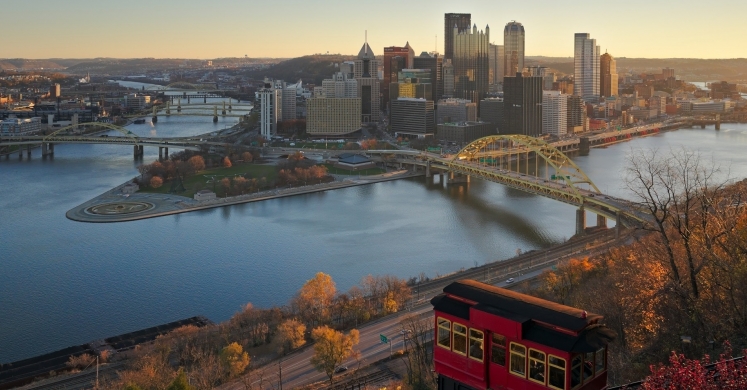Blog

#bioPGH: Rolling Down the Rivers
 A resource of Biophilia: Pittsburgh, #bioPGH is a weekly blog and social media series that aims to encourage both children and adults to reconnect with nature and enjoy what each of our distinctive seasons has to offer.
A resource of Biophilia: Pittsburgh, #bioPGH is a weekly blog and social media series that aims to encourage both children and adults to reconnect with nature and enjoy what each of our distinctive seasons has to offer.
We know how the saying goes, but what happens in the Monongahela River stays in the Monongahela River…and then goes to the Ohio River, and then the Mississippi River and finally the Gulf of Mexico. If you live within Pittsburgh proper, there is a good chance you drive over one of our three rivers on a regular basis. They are a source of drinking water for many of us, a beautiful part of our scenery, a notable industrial transit way and a busy point of recreation. Our waters flow far beyond the state line, though. Let's take a quick little ride down a river and see where we end up, shall we?
Here in Pittsburgh, we know that the Monongahela River (a.k.a., the Mon) flows northward from headwaters in West Virginia to meet the Allegheny River in downtown Pittsburgh at Point State Park, forming the Ohio River. The Ohio River then travels westward, forming state boundaries as it travels along Ohio, West Virginia, Indiana, Kentucky, and Illinois—eventually meeting the Mississippi River near Cairo, Illinois. From there, the Mississippi flows southward until it reaches the Gulf of Mexico. A more fun way to think about it, if bridges weren’t an issue, a Pittsburgher could ride that giant yellow ducky from the Point all the way to the Atlantic Ocean!
In fact, a Pennsylvania-based steamboat company made that very trip a possibility in 1815. The Monongahela and Ohio Steamboat Company, eager to demonstrate the accomplishments of their new technology, sent their steamer the Enterprise on the 2200-mile voyage from New Orleans up the Mississippi, the Ohio, and the Monongahela Rivers back to Brownsville, Pennsylvania. Considering the limited transportation options at the time, travel by river seemed the new frontier of possibility.
However, the thousands of miles of waterway across the country should give us pause as we realize how connected we all are. Waters from West Virginia and Pennsylvania will eventually travel great distances, all the way to an ocean, carrying with it anything that we have allowed into our waterways.
That connection especially problematic very recently in our history. As late as 1967, the Mon was so heavily contaminated by the city’s industrial legacy that fish couldn’t survive in its waters (an EPA survey reported no fish at all in a stretch of the Mon near the city). Imagine living downstream of the Steel City a century ago — imagine being a parent who needed drinking water for their children, a farmer who needed to give water to their livestock, or a small factory owner whose machinery would be tarnished by harsh pollutants. In the last few decades, though, reductions in industrial pollution have greatly improved water quality, and fish populations have started to recover. In fact, a 2010 Fish and Boat Commission survey detected 43 different species of fish living in the Mon, and the Monongahela’s watershed even had its own Watershed Restoration Action Strategy through the Pennsylvania Department of Environmental Protection and the EPA.
We have come a long way in cleaning up our local rivers, but we still have plenty of work to do. As we continue to move forward, it’s important that we remember to be good neighbors to the states downstream of us. As the poem says, no man is an island, operating alone; but in a word-twist way, we can say that no river is an island either. So let’s keep in mind what we send rolling down that river!
Connecting to the Outdoors Tip: With fishing, boating and kayaking, the possibilities for recreation on our rivers are endless! However, we do have an important opportunity to be stewards of our exciting resource. As an older city, Pittsburgh’s combined sewer system, which (literally) combines storm runoff and sewage into a single system, can cause trouble in the water. Any time a heavy rain storm rolls through the area, raw sewage overflows directly into the Mon and the Allegheny at defined locations. The City of Pittsburgh is trying to combat this problem by reducing storm runoff. This is where we as residents come in! We can dramatically reduce how much rain water is forced into the sewers by promoting the creation and maintenance of green spaces and planting trees throughout the city to capture rainfall, encouraging the use of permeable streets and sidewalks in our neighborhoods, and by using rain barrels to collect rainwater for our gardens. This all can help keep our river much cleaner and safer!
Continue the Conversation: Share your nature discoveries with our community by posting to Twitter and Instagram with hashtag #bioPGH, and R.S.V.P. to attend our next Biophilia: Pittsburgh meeting.
Photos: Wikimedia user Dllu CC-BY-SA-4.0 and Billy Hathorn CC-BY-SA-3.0
Resources
EPA: Monongahela River Basin Aquatic Biology 1975
PA DEP: Watershed restoration action strategies
EPA: Soak up the Rain – Trees Help Reduce Runoff
Fish and Boat Commission: Monongahela River Biological Monitoring Study 2010

